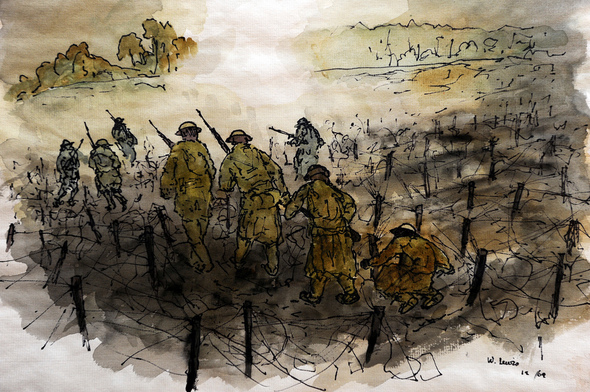Bill Lewis and the art of war

One of Bill Lewis' World War I drawings.
Bill Lewis still remembers one of his earliest drawings. The 92-year-old from Ann Arbor was real young at the time - maybe kindergarten or first grade - and he’d just received an easel, a slate and some chalk from his parents at his childhood home in Grand Rapids. With his new drawing set in tow, Lewis wandered out and sketched a boxcar. Now the only thing left to do was seek out his father’s approval. Lewis regarded his father, an electrical engineer who worked for the phone company his entire life, an expert on everything. His father liked the drawing.
“I’ve been sketching trains ever since.” Lewis said smiling.
Although Lewis never formally studied art, he knew from that moment on, his calling in life was to be an artist.
Of course it wasn’t always easy. Even though his parents had bought Lewis his first art set, they weren’t exactly keen on the idea of having their only child end up an artist, especially while growing up during the Great Depression. “You have to remember,” Lewis said, “during the Great Depression, nobody would be going into something as ridiculous as being an artist.”
But despite the times and lack of parental approval, Lewis’ love of drawing never waned. It wasn’t until he graduated from high school and began junior college in Grand Rapids in 1938, that he feared his art might take a back seat to world affairs when Nazi Germany marched into Austria.

Bill Lewis, 92, in his basement studio at his Ann Arbor home.
Lon Horwedel | AnnArbor.com
Assigned to the gunship Marcasite, which was used mainly as a spotter for other boats in the naval fleet, Lewis found the war was always “just out of reach.” So he made use of his time by sketching boats, and planes, and urban landscapes - loading up on art supplies in San Diego, Pearl Harbor, and later in Seattle where the Marcasite was sent in the summer of 1944 to be a weather boat in the Gulf of Alaska. When the gulf’s rough seas tore apart the Marcasite, Lewis was reassigned to another boat - a carrier called Shangri-La.
It was on board the Shangri-La where Lewis’ sketches and paintings not only got better, but also took on historical importance. When the Shangri-La docked in the Leyte Gulf in July of 1945 with the rest of “MacArthur’s Navy” (every boat in the U.S. Naval fleet that wasn’t still in Europe) to prepare for the final invasion on Japan, Lewis would sit and paint a section of the enormous fleet every day until he painted the “whole thing.”
“Battleships, carriers, torpedo bombers, corsairs - everything!” Lewis said. “I had a buddy who was a signal man, and he pointed out and identified every ship I painted.”
Cameras were forbidden, but no one paid any attention to his drawings, until one day an officer walked past, stopped, looked over Lewis’ shoulder as he painted, and then told him, “You’ll never go crazy!”
After the atomic bombs were dropped, the fleet sailed into Tokyo Bay and Lewis eventually went ashore where he saw the incredible destruction the war had caused on the Japanese homeland.
“Seeing those cities (Tokyo and Yokohama) turned me into a peacenik right on the spot.” Lewis said. “It was the total cleaning out of a culture. This (Tokyo) was a modern place that had just been wiped out.”
When Lewis was in Japan, he ran out of drawing paper, so he started sketching in a small notebook, or on paper lent to him by his fellow sailors.
“They had to end the war,” Lewis joked, “because I was running out of paper!”
By war’s end, Lewis had amassed more than 200 drawings, sketches and paintings. After returning home, Lewis did make his living in the art world, eventually becoming an art professor at the University of Michigan.
In 1995, Lewis’ work from his time at war was put on display at the Clement’s Library at U-M. It wasn’t the first time Lewis had his artwork from war on display. In 1964, his show “The Last Year of the Civil War” went on a national tour.
Now, even at the age of 92, Lewis plans on having yet another show that deals with war. This one he plans to launch in four years to commemorate the centennial of World War I - a war in which four of his uncles fought. “I’ve had that war with me my whole life.” Lewis said, “It’s on my mind - always.”
Lewis has always wanted to do a show on World War I, a war he feels never really ended, picking up where it left off 20 years later as WWII. And now, after years of putting it on the back burner, he’s doing just that.
“This is strictly for me.” He said. “I don’t know where they’re going to go and I really don’t give a damn - I just figure I have to run for another four years to get it done.”
Despite his advanced age, Lewis thinks the odds of being around another four years are in his favor.
“My dad lived to be 96 - my mom was 104,” Lewis said, “and the guy who checks my prostate said he wants to be invited to my 100th birthday, so I guess he thinks I’ll be around.”
In the meantime, Bill Lewis will do what he does best - he’ll take out a piece of paper and he’ll draw.
Lon Horwedel is a photojournalist for AnnArbor.com. He may be reached at lonhorwedel@annarbor.com.


Comments
singlemom79
Fri, May 28, 2010 : 5:42 p.m.
I am glad to see this article made it to this site. But I can't seem to understand why the article on Lloyd Ballard (world war 2 veteran) has not yet made it here. Could someone explain to my why just days before the article was to be published, it has been pulled? I come to this site daily, and for the most part have been satisfied. This article not being here or in this Sundays' paper is extremely disappointing. To pull a story that close to it's publish date is nothing more then a slap in the face to a hero. His story is just as inportant and deserves to be here as much as any other vets. that choose to share their experiences.
antikvetch
Thu, May 27, 2010 : 3:52 p.m.
Longfellow, I did, from antikvetch@gmail.com.
Bill Wilson
Thu, May 27, 2010 : 1:42 p.m.
antikvetch, Your points are quite valid. E-mail me: thecharacterguy@hotmail.com
antikvetch
Thu, May 27, 2010 : 11:17 a.m.
Longfellow, If there was a mea culpa for Two Men story, I did not see it. What I saw was a racially charged tale, referencing a local hero, which was NOT labeled as a parable, written be a staff member of a supposedly fact-based organization. If it had been labeled as fiction, I would not have complained. If the author had indicated that the family subsequently declined to be identified, I would not have complained. However, to simply disappear a story after allegations have been made regarding its factual basis, without ever publicly responding to such allegations, could cause one to conclude that there was some truth to the credibility concerns. Should the Tawana Brawley episode simply be forgotten?
Bill Wilson
Thu, May 27, 2010 : 8:16 a.m.
antikvetch, Let's address this, and move on. I followed up on it, and I was satisfied with the response. The story had elements that could not be verified, so it was removed. I think it's important to note that we're in a different day and age as to publishing. Gone are the days when stories had to be physically laid out, and literally dozens of eyes viewed them before release. Mistakes can occur, but as long they're addressed, as they were in this case, it's really nothing to dwell on. This current piece was quite interesting, and I look forward to more like it.
antikvetch
Wed, May 26, 2010 : 7:10 a.m.
I see the Ernie Harwell "Two Men" story has disappeared without explaination from the archives.....
Epengar
Mon, May 24, 2010 : 12:51 p.m.
Here is a little bit of information about the ships that Mr. Lewis served on. The USS Marcasite (PY-28) was a converted private yacht. It was built in the 20's as the private yacht Camargo, and the US Navy bought it in 1942 from Generalissimo Rafael Trujillo, the dictator of the Dominican Republic (who had named it the Ramfis, after his son). It was 225 feet long, and had a crew of about 120. http://www.history.navy.mil/danfs/m4/marcasite.htm this site has some photos, including one of the ship in the 30's while still a private yacht: http://www.navsource.org/archives/12/1328.htm The converted yachts in this class, mostly purchased by the Navy in 1941 and 1942, were named after gemstones. The USS Shangri-La (CV-38) was an Essex-class aircraft carrier. It got its name from something President Roosevelt said. After the Dolittle air attack on Tokyo in 1942 (launched from the USS Hornet), a reporter asked the President where the attacking bombers had launched from, and he replied "Shangri-La." http://www.history.navy.mil/danfs/s11/shangri-la.htm http://en.wikipedia.org/wiki/USS_Shangri-La_(CV-38) The USS Shangri-La Reunion Association: http://www.uss-shangri-la.com/